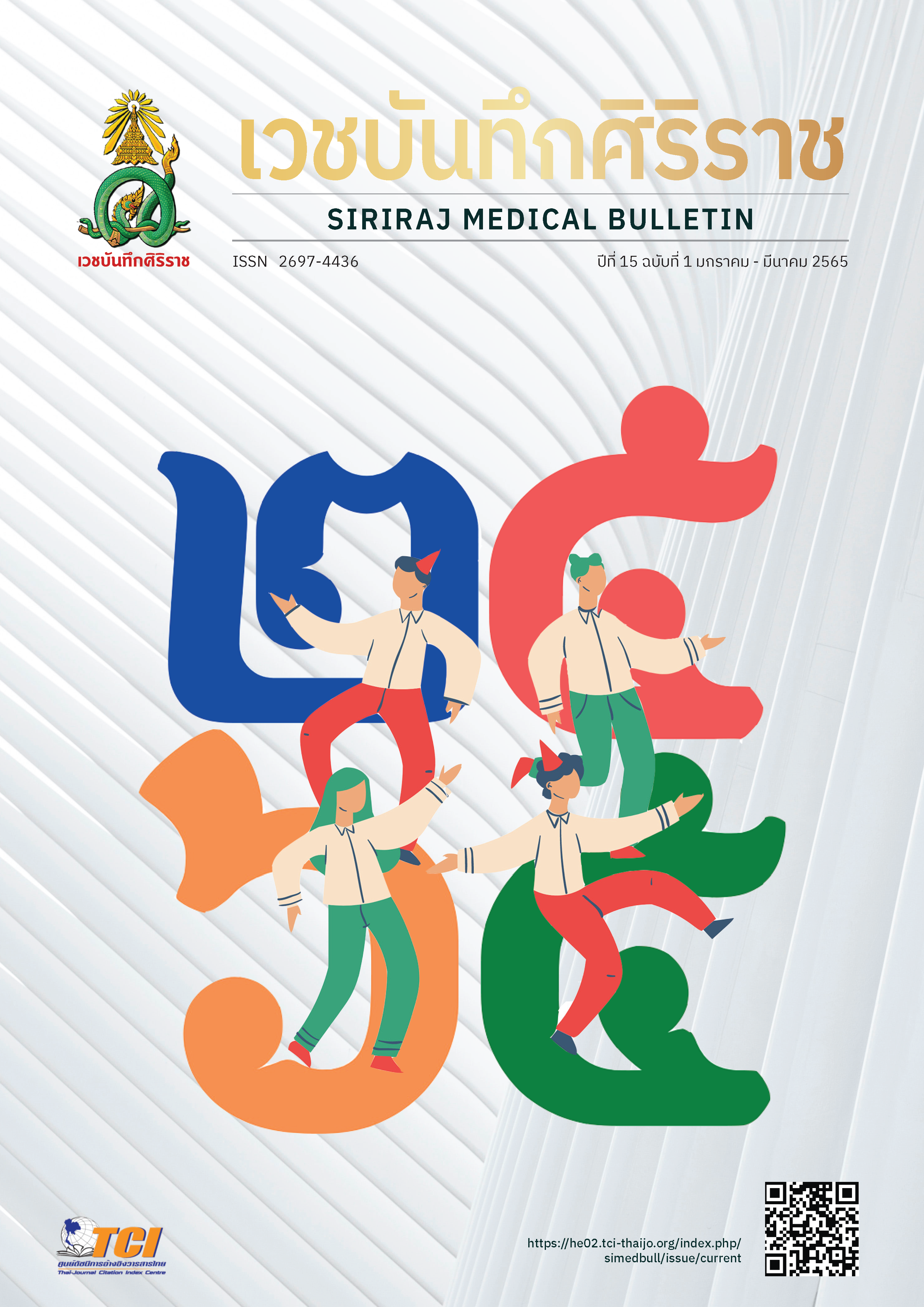Nursing Care for Patient with Severe Acute Pancreatitis
Main Article Content
Abstract
Severe Acute Pancreatitis (SAP) is a critical and serious condition in gastrointestinal system. The disease can affect various organ systems, lead to organs failure and increase mortality rate, especially if a lack of appropriate treatment and immediate responses occurs. The failure of the circulatory system leads to ineffective tissue perfusion, organ failure, and death The critical illness condition may cause anxiety for the patients and family members. This article aims to present holistic nursing guideline for the severe acute pancreatitis patients and patients’ family in term of management on awareness and monitoring of patient's condition. The guideline includes assessment and monitor of fluid resuscitation, level of consciousness, respiratory distress, prognosis of disease, and management of pain and intra-abdominal pressure. The nursing goals are to provide patients with adequate tissue perfusion to prevent organ failure, or facilitate recovery of organ failure, as well as prevent further complications to reduce mortality rate, and improve the quality of life of the patients.
Article Details
References
2. Lee P,Papachristou G. Management of Severe Acute Pancreatitis. Curr Treat Options Gastro .2020; 18:670–81
3. Crockett S D, Wani S, Gardner T, Falck Y, Barkun A, American Gastroenterological Association Institute Guideline on Initial Management of Acute Pancreatitis. Gastroenterology 2018; 154:1096–101
4. Johnstone C. Pathophysiology and nursing management of acute pancreatitis. Nursing Standard .2018. [Internet]. 2018 [cited 2020 December 20]; Available from https://doi: 10.7748/ns.2018.e11179
5. ชัยพิชิต พุทธาพิทักษ์พงศ์.การดูแลโรคตับอ่อนอักเสบเฉียบพลัน. เวชสารแพทย์ทหารบก 2016; 69(2): 89-99
6. Werge M, Novovic S, Schmidt PN, Gluud LL. Infection increases mortality in necrotizing pancreatitis: A systematic review and meta-analysis. Pancreatology. 2016; 16(5):698-70
7. Banks PA, Bollen TL, Dervenis C, Gooszen HG, Johnson CD, Sarr MG, et al. Classification of acute pancreatitis 2012: revision of the Atlanta classification and definitions by international consensus. Gut. 2013; 62(1):102-11
8. Kumar A H & Griwan M S. A comparison of APACHE II, BISAP, Ranson’s score and modified CTSI in predicting the severity of acute pancreatitis based on the 2012 revised Atlanta Classification. Gastroenterology Report. 2018; 6(2): 127–31
9. Takhar R P, Saran R K, Bunkar M, Mirdha K. Respiratory Complications in Acute Pancreatitis. Pancreat Disord Ther 2016; 6:2 120 [Internet]. 2018 [cited 2020 December 20]; Available from https://DOI: 10.4172/2165-7092.1000e149
10. Fan Z & Zhang Y. Grey Turner’s and Cullen’s signs induced by spontaneous hemorrhage of the abdominal wall after coughing. Ann Surgery Treat Res 2017; 93(2): 115-17
11. Zerem E. Treatment of severe acute pancreatitis and its complications. World J Gastroenterol 2014; 20(38): 13879-92
12.Wittau M, Mayer B, Scheele J, Henne-Bruns D, Dellinger EP, Isenmann R. Systematic review and meta-analysis of antibiotic prophylaxis in severe acute pancreatitis. Scand J Gastroenterol. 2011; 46(3): 261-70
13. Mederos M A, Reber H, Girgis M. Acute Pancreatitis A Review. JAMA. 2021; 325(4): 382-90
14. Shu W, Wan J, Chen J, He W, Zhu Y, Zeng H, et al. Gastroenterology. 2020; 20:116. [cited 2021 January 20]; Available from https:// doi.org/10.1186/s12876-020-01268-1
15. Daoud N, Hamby A S, Sharma S, Blevins D. A Review of Alprazolam Use, Misuse, and Withdrawal, J Addict Med. 2018; 12(1): 4–10.
16. Karcioglu O, Topacoglu H. A systematic review of the pain scales in adults: Which to use?. American Journal of Emergency Medicine. 2018; 36(4) [cited 2021 January 20]; Available from https:// doi.org/10.1016/j.ajem.2018.01.008
17. Ahlers J G M, Veen A M, Dijk van M, Tibboel D, Knibbe C A J. The Use of the Behavioral Pain Scale to Assess Pain in Conscious Sedated Patients. Anesth Analg 2010; 110: 127–33
18. Zhao G, Zhang JG, Wu HS, Tao J, Qin Q, Deng SC, et al. Effects of different resuscitation fluid on severe acute pancreatitis. World J Gastroenterol. 2013; 19(13):2044-52
19.Kirkpatrick AW, Roberts DJ, De Waele J, Jaeschke R, Malbrain ML, Keulenaer B, Duchesne J, et al. Intra-abdominal hypertension and the abdominal compartment syndrome: updated consensus definitions and clinical practice guidelines from the World Society of the Abdominal Compartment Syndrome. Intensive Care Med. 2013; 39(7):1190-206
20. Al-Abassi, A, Al Saadi, AS, Ahmed F. Is intra-bladder pressure measurement a reliable indicator for raised intra-abdominal pressure? A prospective comparative study. BMC Anesthesiol 2018; 18: 69. [Internet]. 2020 [cited 2020 September 10]; Available from https://doi.org/10.1186/s12871-018-0539-z






